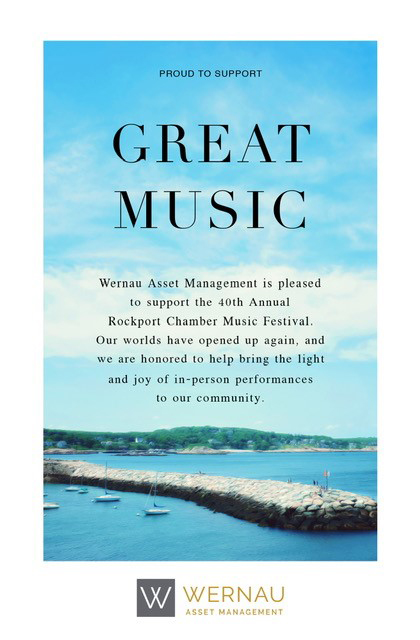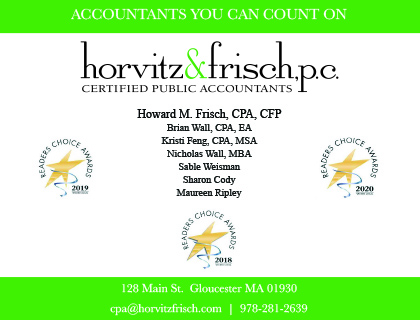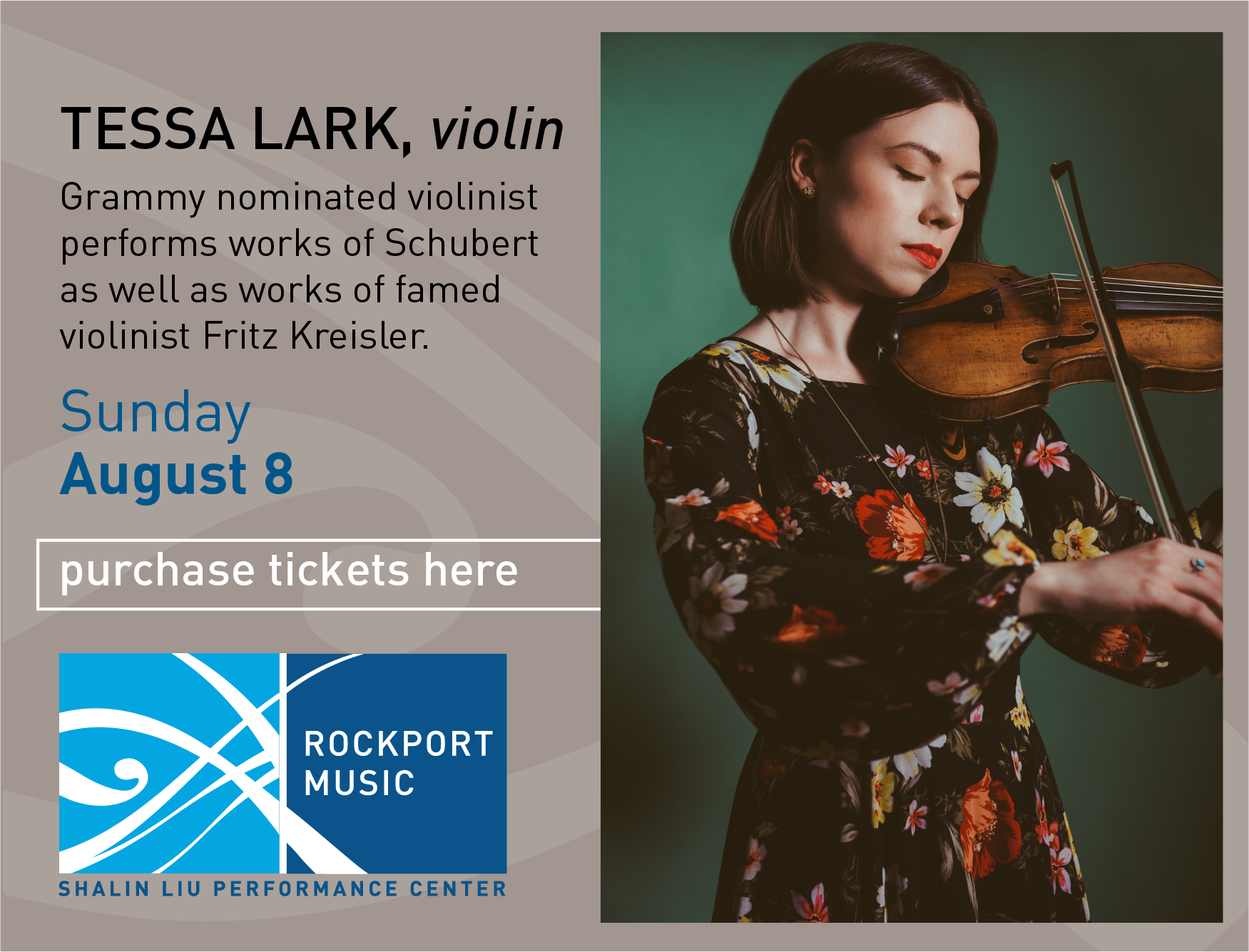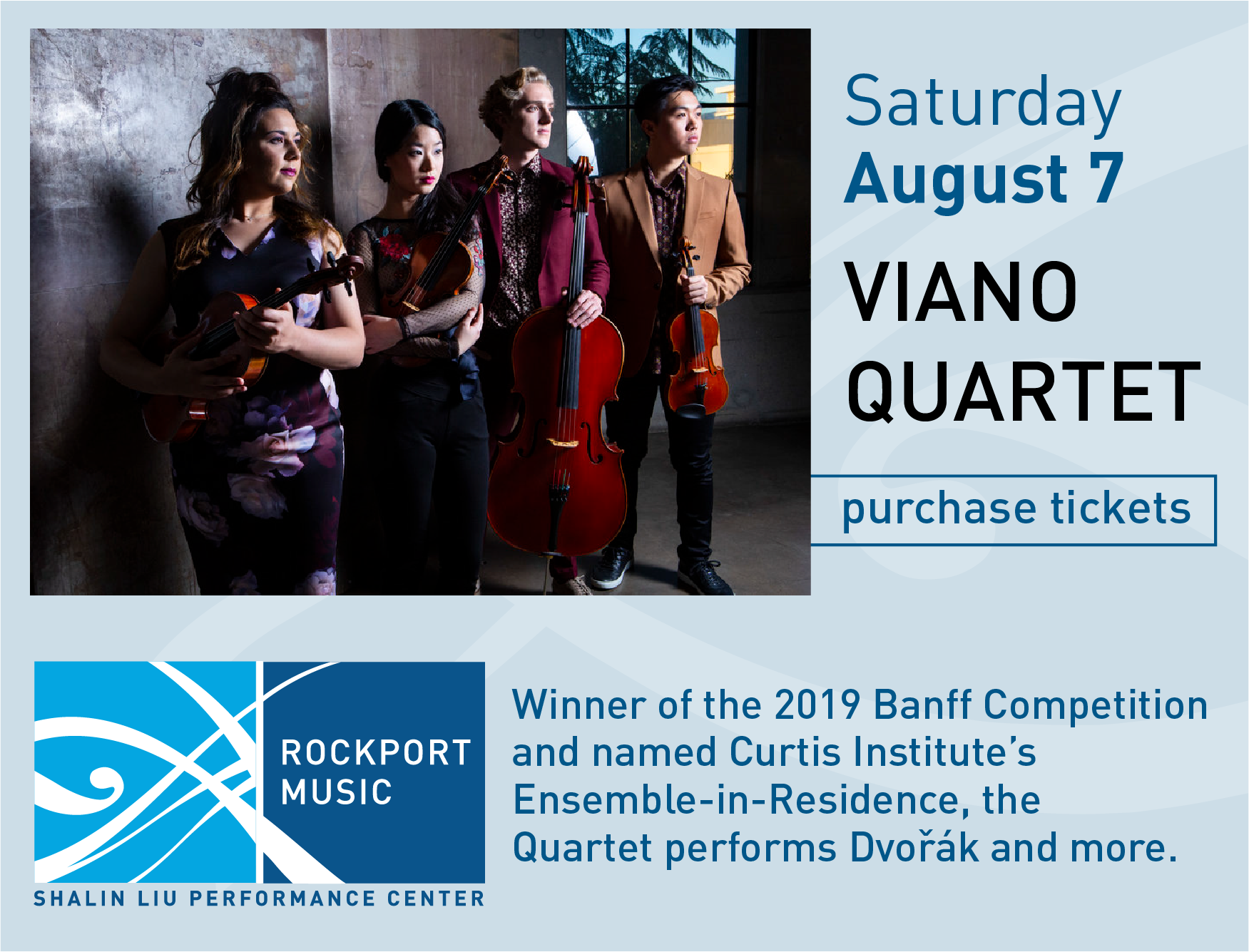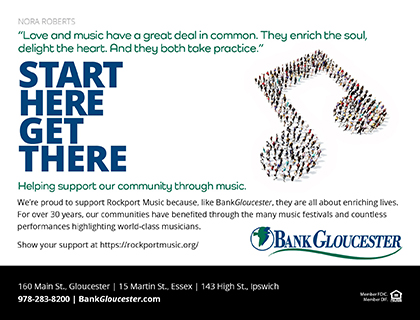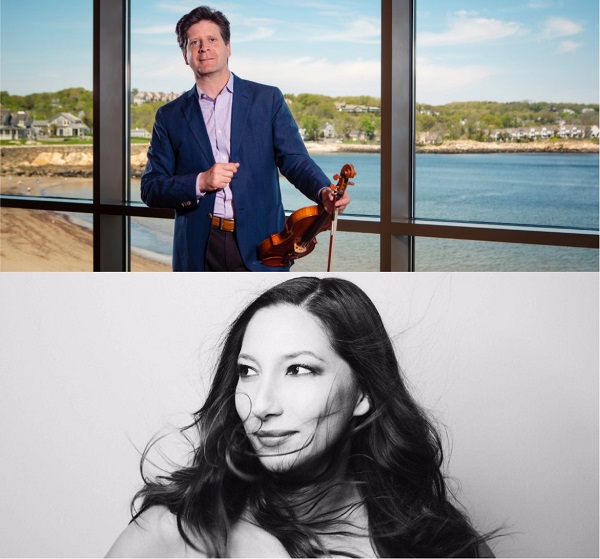
40th ANNUAL
ROCKPORT CHAMBER MUSIC FESTIVAL
Sunday, July 11 :: 5 PM & 8 PM
BARRY SHIFFMAN, violin/viola
AND
TANYA GABRIELIAN, piano
CHACONNE FROM THE PARTITA
IN D MINOR, BWV 1004 (1720)
Johann Sebastian Bach (1685-1750)
SONATA IN F MINOR, FOR VIOLA
AND PIANO, OP. 120, NO. 1 (1894)
Johannes Brahms (1833-1897)
Allegro appassionato
Andante un poco Adagio
Allegretto grazioso
Vivace
FANTASIE NO 1, IN G MINOR, FOR VIOLIN AND PIANO (1933)
FANTASIE NÈGRE NO. 1, IN E MINOR, FOR PIANO (1929)
ADORATION, FOR VIOLIN AND PIANO (1951)
Florence Price (1887-1953)
GENEROUSLY SPONSORED BY GARTH AND LINDSAY GREIMANN
Thank you to our Corporate Sponsor
CHACONNE FROM THE PARTITA IN D MINOR, BWV 1004
Johann Sebastian Bach (b. Eisenach, Germany, March 21, 1685; d. Leipzig, July 28, 1750)
Composed 1720; 13 minutes
 Bach’s magnificent, stately Chaconne first appeared as the crowning movement of the D minor Partita for solo violin – the second of a collection of six Partitas and Sonatas, representing the culmination of Baroque polyphonic writing for a string instrument. A chaconne is, traditionally, a Baroque dance and instrumental form presenting a sequence of continuous variations on a four-bar phrase. Its origins lie in 17th century lute music, song and dance. The 64 variations of Bach’s Chaconne, one of only two surviving chaconnes by Bach, present a formidable array of technically challenging melodic and harmonic variations over a four-bar ground, juxtaposing the Italian and French styles of the day. The piece has challenged both performers and arrangers for almost three centuries. As a non-violinist, Brahms felt that he could only truly appreciate what called “one of the most wonderful and most incomprehensible pieces of music,” by transcribing it for the left hand alone, on the piano. Mr. Shiffman will use both hands in his viola transposition, in G minor.
Bach’s magnificent, stately Chaconne first appeared as the crowning movement of the D minor Partita for solo violin – the second of a collection of six Partitas and Sonatas, representing the culmination of Baroque polyphonic writing for a string instrument. A chaconne is, traditionally, a Baroque dance and instrumental form presenting a sequence of continuous variations on a four-bar phrase. Its origins lie in 17th century lute music, song and dance. The 64 variations of Bach’s Chaconne, one of only two surviving chaconnes by Bach, present a formidable array of technically challenging melodic and harmonic variations over a four-bar ground, juxtaposing the Italian and French styles of the day. The piece has challenged both performers and arrangers for almost three centuries. As a non-violinist, Brahms felt that he could only truly appreciate what called “one of the most wonderful and most incomprehensible pieces of music,” by transcribing it for the left hand alone, on the piano. Mr. Shiffman will use both hands in his viola transposition, in G minor.
SONATA IN F MINOR, FOR VIOLA AND PIANO, OP. 120 NO. 1
Johannes Brahms (b. Hamburg, Germany, May 7, 1833; d. Vienna, Austria, April 3, 1897)
Composed 1894; 23 minutes
.png) By today’s standards, thoughts of retirement came relatively early to Brahms. He was just 57 when he wrote to his publisher: “The time has now come for you to say goodbye to any further compositions of mine.” He drew up a will. Music lovers, however, were still eager to hear more from the composer whose musical bloodlines reached back through German romanticism and the great Viennese classical composers to Bach, almost a century and a half earlier. But honorary degrees, medals and elegies to the dead provided no incentive for Brahms to create more. Then, in 1891, on a visit to Meiningen to hear the orchestra, Brahms discovered something new and stimulating in the playing of the court clarinetist Richard Mühlfeld. He then composed the beautiful, autumnal Clarinet Quintet and the Clarinet Trio for Mühlfeld during the summer. That may have been the end of it but, three years later, in the spring of 1894, Brahms again heard the court clarinetist. This time the musical fallout was a pair of sonatas that not only provided clarinetists with two of the finest works in the repertoire, but also provided viola players with the very first substantial duo works for their instrument.
By today’s standards, thoughts of retirement came relatively early to Brahms. He was just 57 when he wrote to his publisher: “The time has now come for you to say goodbye to any further compositions of mine.” He drew up a will. Music lovers, however, were still eager to hear more from the composer whose musical bloodlines reached back through German romanticism and the great Viennese classical composers to Bach, almost a century and a half earlier. But honorary degrees, medals and elegies to the dead provided no incentive for Brahms to create more. Then, in 1891, on a visit to Meiningen to hear the orchestra, Brahms discovered something new and stimulating in the playing of the court clarinetist Richard Mühlfeld. He then composed the beautiful, autumnal Clarinet Quintet and the Clarinet Trio for Mühlfeld during the summer. That may have been the end of it but, three years later, in the spring of 1894, Brahms again heard the court clarinetist. This time the musical fallout was a pair of sonatas that not only provided clarinetists with two of the finest works in the repertoire, but also provided viola players with the very first substantial duo works for their instrument.
Brahms may have conceived his F minor and E-flat major sonatas for clarinet but he immediately realized that they worked just as well on viola. Indeed, it has been convincingly argued that the viola’s darker, edgier string sound is more suited to probe their fleeting mood changes than the rounder, more burnished sound of the clarinet. The two sonatas are strongly contrasted – like Beethoven before him, Brahms had made a practice of simultaneously working on two contrasting compositions. The First Sonata is the more dramatic of the two and begins with a turbulent Allegro appassionato in F minor, his favorite key for passionate music since his youth. An elegant, dreamy slow movement and more down-to-earth Intermezzo lead into a jubilant, but still business-like finale. The music throughout is compact and concentrated in thought, yet still presents an unhurried, expansive exterior.
FANTASIE NO 1, IN G MINOR, FOR VIOLIN AND PIANO
FANTASIE NÈGRE NO. 1, IN E MINOR, FOR PIANO
ADORATION, FOR VIOLIN AND PIANO
Florence Price (b. Little Rock, AR, April 09, 1887; d. Chicago, IL, June 3, 1953)
Composed 1933, 1929 and 1951 respectively; 4 minutes, 8 minutes and 3 minutes
FLORENCE PRICE . . . TIMELINE
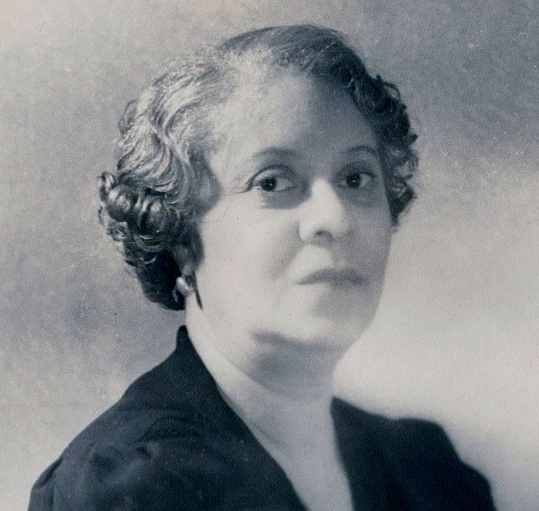 1887 April 9, Florence Beatrice Smith is born in Little Rock, Arkansas to a singer/pianist mother who also has business interests and the city’s only African American dentist father. The family lives comfortably and is well respected. Composer William Grant Still, eight years younger, grew up as a neighbor.
1887 April 9, Florence Beatrice Smith is born in Little Rock, Arkansas to a singer/pianist mother who also has business interests and the city’s only African American dentist father. The family lives comfortably and is well respected. Composer William Grant Still, eight years younger, grew up as a neighbor.- 1891 Gives her first piano recital.
- 1898 Publishes her first piece.
- 1901 Graduates from high school at 14, valedictorian of her class.
- 1903 Enrolls at New England Conservatory of Music in Boston, majoring in piano and organ, listing her hometown as ‘Pueblo, Mexico.’ In private lessons, composer and Conservatory director George Whitefield Chadwick encourages her to incorporate African American folk melodies and rhythms into her compositions.
- 1906 Graduates in three years (not the usual four) with honors, aged 19.
- 1910 Teaches as Head of the music department at Clark College in Atlanta.
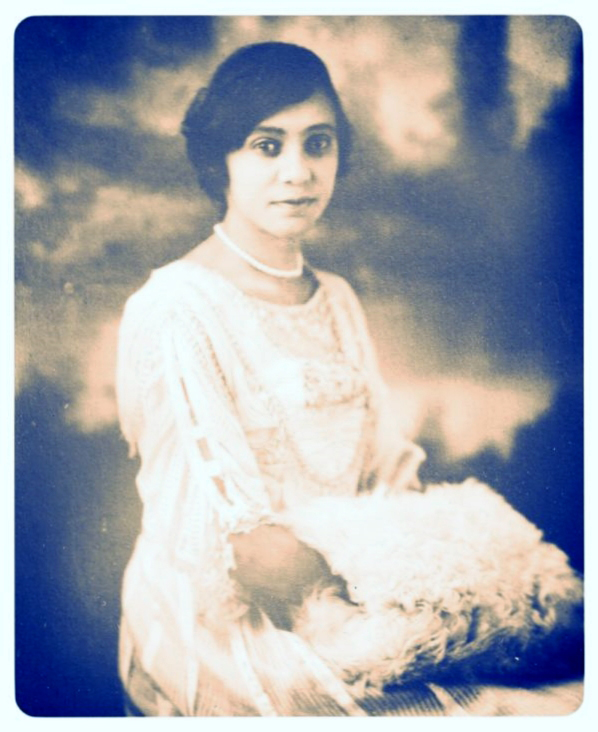 1912 Marries lawyer Thomas J Price in Atlanta, but the couple moves back to Little Rock where Price composes and teaches privately. Refused admission to the all-white Arkansas Music Teachers Association, she also teaches music at segregated black schools.
1912 Marries lawyer Thomas J Price in Atlanta, but the couple moves back to Little Rock where Price composes and teaches privately. Refused admission to the all-white Arkansas Music Teachers Association, she also teaches music at segregated black schools. - 1927 Racial riots following a murder and a lynching forces 400 Black people to leave Little Rock. The Price family, now including two daughters, relocates to Chicago. Price pursues further education at the American Conservatory and the Chicago Musical College.
- 1928 The G. Schirmer and McKinley music publishers begin to release Price’s songs, piano pieces and instructional keyboard music.
- 1931 With Thomas Price losing his job in the Great Depression and becoming abusive, Florence files for divorce after nearly 20 years of marriage. Price, now a single parent, moves in with the Bonds family, prominent in the Chicago music community. Margaret Bonds is a former pupil.
- 1932 Wins overall prize in the Rodman Wanamaker Music competition with her Symphony No. 1, in E minor and first prize with a Piano Sonata in the same key.
- 1933 Her symphony is performed at the Chicago World’s Fair by the Chicago Symphony Orchestra and Frederick Stock, making Price the first Black woman to have her music performed by a major symphony orchestra. “It is a faultless work, a work that speaks its own message with restraint and yet with passion . . . worthy of a place in the regular symphonic repertory,” writes the Chicago Daily News.
- 1933 Composer John Alden Carpenter sponsors Price for membership in ASCAP (American Society of Composers, Authors, and Performers).
 1934 Her music is regularly performed in churches and community settings of all sizes by many groups including the Chicago Treble Clef Glee Club which she directs, the Florence B. Price A Cappella Chorus, the Chicago Women’s Symphony and the WPA Symphony of Detroit.Price is also an active member of NANM (National Association of Negro Musicians). She composes popular songs under the name Vee Jay, plays organ in the movie houses, and orchestrates for WGN radio. Many of her works are taken up by bands, women’s organizations, and symphony orchestras.
1934 Her music is regularly performed in churches and community settings of all sizes by many groups including the Chicago Treble Clef Glee Club which she directs, the Florence B. Price A Cappella Chorus, the Chicago Women’s Symphony and the WPA Symphony of Detroit.Price is also an active member of NANM (National Association of Negro Musicians). She composes popular songs under the name Vee Jay, plays organ in the movie houses, and orchestrates for WGN radio. Many of her works are taken up by bands, women’s organizations, and symphony orchestras.- 1939 Price’s exuberant arrangement of ‘My Soul’s Been Anchored in de Lord’ is performed by Marian Anderson on the steps of the Lincoln Memorial in front of an integrated audience of 75,000 and on national radio, on Easter Sunday.
- 1943 in a November 6 letter to Serge Koussevitzky, conductor of the Boston SO, asking that he reviews her music, Price writes: “Unfortunately the work of a woman composer is preconceived by many to be light, frothy, lacking in depth, logic, and virility. Add to that the incident of race – I have Colored blood in my veins – and you will understand some of the difficulties that confront one in such a position.”
- 1951 Sir John Barbirolli commissions a Suite for strings, incorporating traditional spirituals, for the Hallé Orchestra in England. Ill health prevents Price attending the première.
- 1953 Dies June 3, 1953 in Chicago from a stroke.
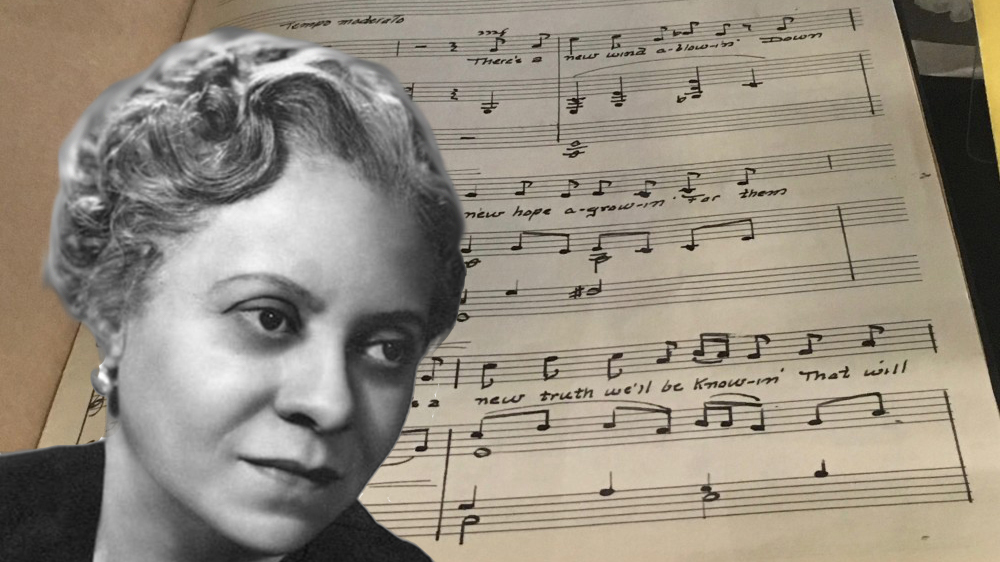
- 2009 Dozens of Price’s manuscripts thought lost are found in St. Anne, Illinois in a summer house about to be renovated. These include her two violin concertos and Fourth Symphony.
- 2021 Website https://florenceprice.com/ goes online
Florence Price left a substantial output of over 300 works including 4 symphonies, a piano concerto and Rhapsody, two violin concertos, several tone poems, choral pieces, over 100 songs and arrangements, plus works for strings, piano and organ. Much of the music remains unpublished and is constantly being reviewed and seen under a new lens as time and social awareness evolve. Some has been recorded on CD, more is posted on YouTube, Soundcloud and other online performance portals, all providing a valuable window onto a neglected composer. A biography by the late Rae Linda Brown titled The Heart of a Woman: the Life and Music of Florence B. Price (Urbana, IL, 2002) brings valuable new research and authenticity to our knowledge of a modest woman who gave few interviews and generally shunned the limelight.
In her music Price frequently marries traditional European structures with melodic writing drawn from her heritage of spirituals, folk, religious and popular music. Her music resonates with Antonin Dvořák’s call, two or three decades earlier (when spending two and a half years as director of the New York Conservatory), to establish an American national school of music founded on African American and indigenous folk music. The two worlds are immediately apparent with the opening and closing technical brilliance of the Fantasie No 1, in G minor, for violin and piano (1933), which enclose variations on a lively folk tune alternating with a more reflective spiritual-like melody.
The Fantasie nègre No. 1, in E minor, for piano (1929) takes the spiritual “Sinner, please don’t let this harvest pass” as the basis for an emotionally wide-ranging sequence of variations. The piece, dated February 9-10, 1929 carries a dedication “To my talented little friend Margaret Bonds.” Two years later, Price would live in Chicago with the Bonds family. Margaret herself was a prizewinner in the 1932 Wanamaker Music competition which also brought Price’s symphonic writing to national attention. At the time of the dedication of this piece, Margaret Bonds was just 16 and beginning her studies in piano and composition at Northwestern University.
Adoration, for violin and piano (1951) was originally written and published in 1951 for organ, though I wonder whether it had an earlier life as a song perhaps? Its beautiful, life affirming melody has provided solace for many during the pandemic and carried the name of Florence B. Price around the world (as a quick search on YouTube will reveal).
— Program notes © 2021 Keith Horner.
Comments welcomed: khnotes@sympatico.ca

